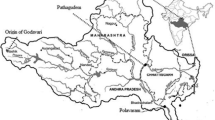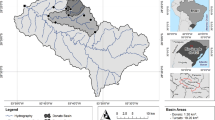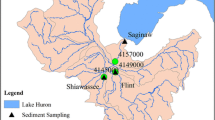Abstract
The present research was carried out by using artificial neural network (ANN), adaptive neuro-fuzzy inference system (ANFIS), cokriging (CK) and ordinary kriging (OK) using the rainfall and streamflow data for suspended sediment load forecasting. For this reason, the time series of daily rainfall (mm), streamflow (m3/s), and suspended sediment load (tons/day) data were used from the Kojor forest watershed near the Caspian Sea between 28 October 2007 and 21 September 2010 (776 days). Root mean square error, efficiency coefficient, mean absolute error, and mean relative error statistics are used for evaluating the accuracy of the ANN, ANFIS, CK, and OK models. In the first part of the study, various combinations of current daily rainfall, streamflow and past daily rainfall, streamflow data are used as inputs to the neural network and neuro-fuzzy computing technique so as to estimate current suspended sediment. Also, the accuracy of the ANN and ANFIS models are compared together in suspended sediment load forecasting. Comparison results reveal that the ANFIS model provided better estimation than the ANN model. In the second part of the study, the ANN and ANFIS models are compared with OK and CK. The comparison results reveal that CK was a better estimation than the OK. The ANFIS and ANN models also provided better estimation than the OK and CK models.















Similar content being viewed by others
References
Abrahart RJ, White SM (2001) Modelling sediment transfer in Malawi: comparing backpropagation neural network solutions against a multiple linear regression benchmark using small data sets. Phys Chem Earth Part B: Hydrol Oceans Atmos 26:19–24
Agarwal A, Mishra SK, Ram S, Singh JK (2006) Simulation of runoff and sediment yield using artificial neural networks. Biosys Eng 94:597–613
Alp M, Cigizoglu HK (2007) Suspended sediment load simulation by two artificial neural network methods using hydrometeorological data. Environ Model Software 22:2–13
Anctil F, Lauzon N (1999) Generalisation for neural networks through data sampling and training procedures, with applications to streamflow predictions. Hydrol Earth Syst Sci 8:940–958
Ardiclioglu M, Kisi O, Haktanin T (2007) Suspended sediment prediction using two different feed-forward back-propagation algorithms. CaJCE 34:120–125
Cigizoglu HK (2004) Estimation and forecasting of daily suspended sediment data by multi-layer perceptrons. AdWR 27:185–195
Cigizoglu HK, Alp M (2006) Generalized regression neural network in modelling river sediment yield. Adv Eng Softw 37:63–68
Cigizoglu HK, Kisi O (2005) Flow prediction by three back propagation techniques using k-fold partitioning of neural network training data. Nord Hyd 36:49–64
Cigizoglu HK, Kisi Ö (2006) Methods to improve the neural network performance in suspended sediment estimation. JHyd 317:221–238
Cobaner M, Unal B, Kisi O (2009) Suspended sediment concentration estimation by an adaptive neuro-fuzzy and neural network approaches using hydro-meteorological data. JHyd 367:52–61
Coulibaly P, Anctil F, Bobée B (1999) Prévision hydrologique parréseaux de neurones artificiels: etatdel art. CaJCE 26:293–304
Edwards TK, Glysson GD (1999) Field methods for measurement of fluvial sediment. USGS Open-file Report 1–97
Gautam MR, Watanabe K, Saegusa H (2000) Runoff analysis in humid forest catchment with artificial neural network. JHyd 235:117–136
Hagan MT, Menhaj MB (1994) Training feedforward networks with the Marquardt algorithm. Neural Networks IEEE Trans 5:989–993
Hamidi N, Kayaalp N (2008) Estimation of the amount of suspended sediment in the Tigris River using artificial neural networks. Clean—Soil Air Water 36:380–386
Hsu K-l, Gupta HV, Sorooshian S (1995) Artificial neural network modeling of the rainfall–runoff process. Water Resour Res 31:2517–2530
Jain SK (2001) Development of integrated sediment rating curves using ANNs. J Hydraul Eng 127:30–37
Jang JSR (1993) ANFIS: adaptive-network-based fuzzy inference system. Syst Man Cybern IEEE Trans 23:665–685
Karamouz M, Araghinejad S (2005) Advanced hydrology. Tehran Polytechnic Press, Tehran, p 465, In Persian
Kisi O (2004) Multi-layer perceptrons with Levenberg–Marquardt optimization algorithm for suspended sediment concentration prediction and estimation. Hydrol Sci J 47:1025–1040
Kisi Ö (2008) Constructing neural network sediment estimation models using a data-driven algorithm. Math Comput Simul 79:94–103
Kisi Ö (2009) Evolutionary fuzzy models for river suspended sediment concentration estimation. JHyd 372:68–79
Kisi Ö (2010) River suspended sediment concentration modeling using a neural differential evolution approach. JHyd 389:227–235
Kisi O, Haktanira T, Ardiclioglua M, Ozturka O, Yalcinb E, Uludagb S (2009) Adaptive neuro-fuzzy computing technique for suspended sediment estimation. Adv Eng Software 40:438–444
Li Z, Zhang Y-K, Schilling K, Skopec M (2006) Cokriging estimation of daily suspended sediment loads. JHyd 327:389–398
McCulloch WS, Pitts W (1988) A logical calculus of the ideas immanent in nervous activity. In: Neurocomputing: foundations of research. MIT Press pp 15–27
Melesse AM, Ahmad S, McClain ME, Wang X, Lim YH (2011) Suspended sediment load prediction of river systems: an artificial neural network approach. Agric Water Manage 98:855–866
Nowshahr Natural Resources General Office (2002) Kojor silviculture project, Aghozchal parcel 3, Watershed 46. Jihad-e-Agriculture, Forest, Range and Watershed management Organization of Iran:379
Partal T, Cigizoglu HK (2008) Estimation and forecasting of daily suspended sediment data using wavelet-neural networks. JHyd 358:317–331
Rajaee T, Mirbagheri SA, Zounemat-Kermani M, Nourani V (2009) Daily suspended sediment concentration simulation using ANN and neuro-fuzzy models. Sci Total Environ 407:4916–4927
Raman H, Sunilkumar N (1995) Multivariate modelling of water resources time series using artificial neural networks. Hydrol Sci J 40:145–163
Sadeghi SHR, Saeidi P (2010) Reliability of sediment rating curves for a deciduous forest watershed in Iran. Hydrog Sci J 55(5):821–831
Sarangi A, Bhattacharya AK (2005) Comparison of Artificial Neural Network and regression models for sediment loss prediction from Banha watershed in India. Agric Water Manage 78:195–208
Sudheer KP, Gosain AK, Ramasastri KS (2002) A data-driven algorithm for constructing artificial neural network rainfall-runoff models. HyPr 16:1325–1330
Tayfur G (2002) Artificial neural networks for sheet sediment transport. Hydrol Sci J 47:879–892
Tayfur G, Guldal V (2006) Artificial neural networks for estimating daily total suspended sediment in natural streams. Nord Hydrol 37:69–79
Zhu Y-M, Lu XX, Zhou Y (2007) Suspended sediment flux modeling with artificial neural network: An example of the Longchuanjiang River in the Upper Yangtze Catchment, China. Geomo 84:111–125
Author information
Authors and Affiliations
Corresponding author
Rights and permissions
About this article
Cite this article
Vafakhah, M. Comparison of cokriging and adaptive neuro-fuzzy inference system models for suspended sediment load forecasting. Arab J Geosci 6, 3003–3018 (2013). https://doi.org/10.1007/s12517-012-0550-5
Received:
Accepted:
Published:
Issue Date:
DOI: https://doi.org/10.1007/s12517-012-0550-5




